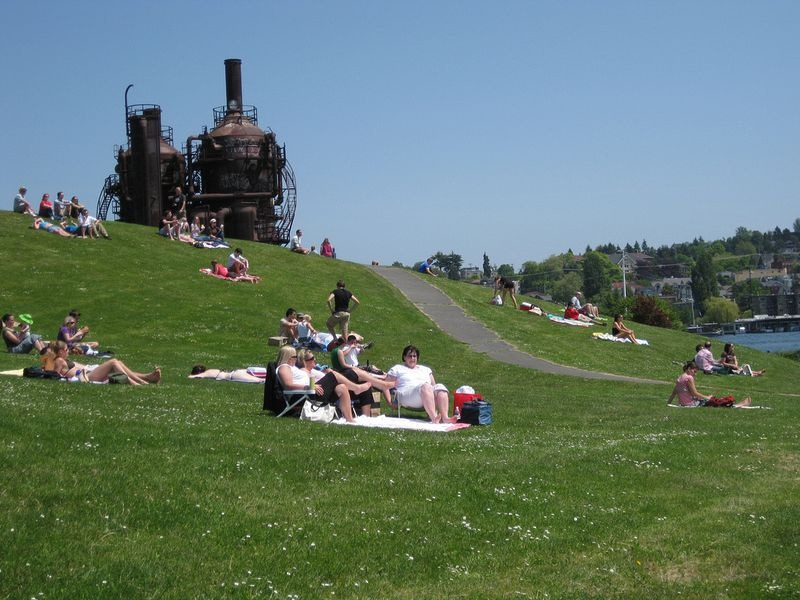Gas Works Park in Seattle, Washington, is an unusual public park located on the site of a former coal gasification plant, on the shores of Lake Union opposite downtown Seattle. The 19-acre site was acquired by the city in 1962, seven years after the plant shut down, and opened to the public as a park in 1975. The park incorporates much of what was left of the gasification plant — the boiler house was converted to a picnic shelter complete with tables and fire grills, while the exhauster-compressor building was transformed into an open-air play barn, housing a maze of brightly painted machinery for children.
The gasification plant of Seattle Gas Light Company was built 1906. Throughout the first half of the twentieth century, the Gas Company was a significant participant in and contributor to the growth of Seattle and adjoining communities. It’s primary product was coal gas used for lighting, cooking, refrigeration, and heating homes and water. Additionally, the plant manufactured other basic products necessary for urban growth such as tar for roofing, lampblack for pigment in tires and ink, charcoal briquets for odor-free and efficient home heating, sulfur for chemicals and toluene for use in explosives. The plant ceased production of coal gas in 1956 when Seattle converted to natural gas.
By 1962, the city had acquired the site with the intention of turning it into a public park, and with that in mind, hired Seattle-based landscape architect Richard Haag to do the landscaping work. The city officials expected Haag to tear the structure down, but when Haag announced he wanted to keep some of the buildings, he was met with immediate backlash from politicians and the Wallingford residents who considered the plant a blight on the neighborhood. However, with some luck, Haag was hired and was allowed to keep the buildings as relics of the industrial age.
If convincing the city government to accept this radical plan was not challenging enough, Haag also had to develop a design that could decontaminate the soil off harmful toxins without harming the plant building. Instead of removing the contaminated soil, Haag decided to deal with it by using natural microbes and sewage. He added oil-degrading enzymes to the soil, as well as organic materials to fertilize the growth of soil microorganisms that naturally broke down the toxic contaminants in the topsoil. Haag’s bio-remediation approach worked, but only to some extent. In mid-1980s the US Environmental Protection Agency undertook additional measures, including removing and capping of wastes to further detoxify the sity. Occasionally, tar still oozes from some locations within the site and is isolated and removed.
Regardless of the continued environmental issues, Gas Works Park is one of the most popular public parks in Seattle today. The park was for many years the exclusive site of a summer series of "Peace Concerts”. The park also has for many years hosted one of Seattle's two major Fourth of July fireworks events. It is also the traditional end point of the Solstice Cyclists and the start point for Seattle's World Naked Bike Ride.
In 2013, the park was added to the National Register of Historic Places.

Sources: Wikipedia / The Cultural Landscape Foundation / City Living Seattle























Cool idea. I love the brightly painted industrial equipment. Very unique. Of course there's graffiti everywhere, because the pre-sentient apes who inhabit our inner cities love to shit where they eat.
ReplyDelete